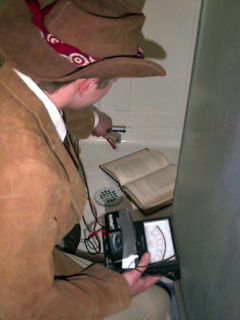ARP CONCLUDES INVESTIGATION OF
POLTERGEIST PHENOMENA

ARP Director, William Posey IV takes readings from a book that mysteriously appeared in a shower stall of the Brunwald House.
The team witnessed and recorded myriad strange happenings in the house, including dozens of instances of electrical appliances turning on and off by themselves, untouched objects falling from heights, three eerily glowing manifestations of light from and unknown origin, and the disappearance of several objects. "The disappearances and apportations were never witnessed," cautions Posey. "What we do know is that something or someone was moving these things around, but we have no proof that these disturbances were supernatural in cause."
The team's high-tech equipment was put to full use in the house, some of it not fully tested in the laboratory. Special spectrometers were placed at locations around the house where objects were most likely to move about. Shelves in the living room seemed especially prone to this phenomena. The researchers analyzed the data on several items' movements, including a tin cup full of pens and pencils that tipped over, and a steel cross that levitated slightly. Physicist Randall Beecher of the ARP has gone over the data thoroughly.
"The movement of objects that we actually recorded in the Brunwald case has a certain number of significant characteristics. First, objects moved regardless of whether or not there was anyone in the room. Second, all of the objects were at least partly metallic, and were near to or touching one of the walls when the action took place. In addition, our instruments recorded electromagnetic activity at the time of each disturbance. This energy is most certainly what caused the burst of motion. We were able to record this phenomenon repeatedly over a period of several weeks by placing affected objects in their original, pre-movement locale. But when the objects were placed elsewhere in the room, they were unaffected by any 'supernatural forces.'"
Ghost lights in the house were subjected to the same level of scrutiny. Again, electromagnetic charges were present, and in this case, appeared to be producing a photoelectric effect. Posey suggests that these ghost lights are not unlike the faint glow given off by a television that has just been turned off. "You can especially see this phenomenon in older television models," he notes. "In a dark room, a freshly turned-off television screen has a slight glow. And if you touch the screen, you may observe the glow of residual electrons lingering along the screen's internal surface attracted to the positive charge of your hand. Eventually this effect dissipates, but the screen's glow can last several minutes."
The team evaluated their readings and came to a conclusion. "This house is not haunted, nor is it under stress from psychic powers. The most reasonable explanation is that the house itself is producing these effects, not something in it," Posey explains.
"We did further research into the house and the others in the neighborhood nearby. What we found was remarkable, but wholly natural. Some of the Brunwald's neighbors, who live in similar, early twentieth-century homes, have witnessed similar phenomena in their own houses. It seemed unreasonable to think that all these houses could have their own personal poltergeist, but something had to account for it!"
That's when the Iowa Geological Survey came to the rescue. The Project learned from the IGS that the earth underneath Hopkins Grove contained large amounts of quartz crystal, as well as iron. The Brunwald poltergeist was now showing its true face.
"What we have here in this section of Hopkins Grove is a marvelous display of the wonders of electromagnetics," Dr. Beecher says with a smile. "The quartz here is under a lot of geophysical stress. And as pressure builds in quartz, a static charge is produced called a "piezo-electric effect". With the high concentration of iron in the earth here as well, this energy is transmitted to the surface, where it eventually works its way into the houses. The Brunwald home, like many of the other older homes in its neighborhood, contains high amounts of ferrous material, and has very outdated and often uninsulated wiring. All this allows the charge from the quartz to manifest itself variously as static-electric glowing, bizarre surges and shorts in electrical systems, as well as occasional instances of weak magnetic-levitation of objects."
Posey has explained the group's findings to the Brunwalds, and suggests that rewiring the house and adding insulation should cut down significantly on disturbances in the house. Having completed their research using conventional methods, Posey has still not had the chance to use the drug I-Gazi II to try to peer into the world of psychic phenomena. The team will continue to investigate hauntings, but it appears that in this case, the only thing doing the haunting is nature itself.
Back to this Issue Contents
